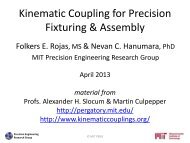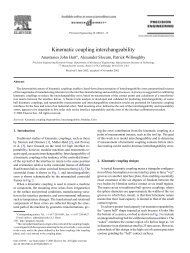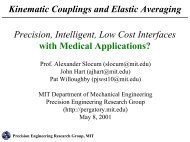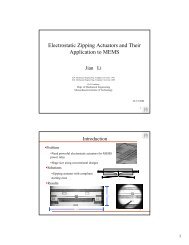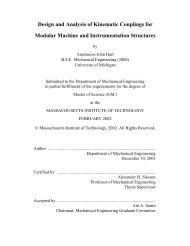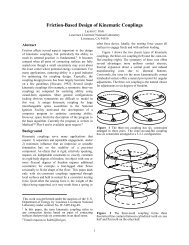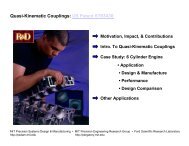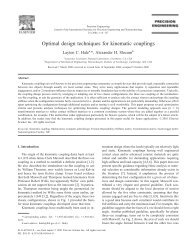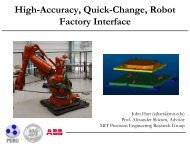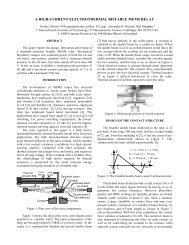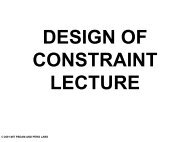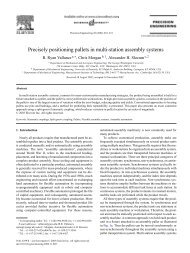Design of a Hybrid Positioner-Fixture for Six-axis Nanopositioning ...
Design of a Hybrid Positioner-Fixture for Six-axis Nanopositioning ...
Design of a Hybrid Positioner-Fixture for Six-axis Nanopositioning ...
Create successful ePaper yourself
Turn your PDF publications into a flip-book with our unique Google optimized e-Paper software.
<strong>Design</strong> <strong>of</strong> a <strong>Hybrid</strong> <strong>Positioner</strong>-<strong>Fixture</strong> <strong>for</strong> <strong>Six</strong>-<strong>axis</strong> <strong>Nanopositioning</strong> and Precision FixturingSubmitted to Precision Engineering3E w t(21)26 aK yz3E w t(22)26 aK zy3E w tz (23)26 aK y34G wt16t t 3.3614 (24)16a 3 w 12w K xx3E w t (25)12 aK yy3E wtK zz (26)12 aand, t = thickness <strong>of</strong> beam, a = length <strong>of</strong> beam, w = width <strong>of</strong> beam, E = Young’s modulus, and G = shearmodulus. Through this parametric model, it is possible to optimize the stiffness properties, e.g. low indirections <strong>of</strong> desired motion and high in other directions/rotations, by tuning design the flexure’s designparameters.4.3. Guiding flexure bearingThe purpose <strong>of</strong> the guiding flexure is to ensure that the grooves are actuated with smooth motion andalong a linear path. Figure 13 shows the conceptual model in which actuators are mounted into six sets <strong>of</strong>linear flexure bearings, e.g. guide flexure bearings, within a monolithic base. This design simplifiesfabrication <strong>of</strong> the HPF as the base may be cut as a single piece via EDM or abrasive waterjet cutting. Thegeometry <strong>of</strong> the flexures may be biased such that they provide a preload on the actuator in the nonactuatedstate.FlexurePlate mountbolt holesActuatorFlexureMonolithicbaseFigure 13: Top view <strong>of</strong> groove guide flexure bearings as machined within monolithic blockA model <strong>of</strong> the guided flexure bearing is shown in Fig. 14. For a guiding motion range, z, <strong>of</strong> 50µm andbeam thickness, t = 1 mm, ( z / t ) 2 = 0.0025 < 1, there<strong>for</strong>e stress stiffening <strong>of</strong> the beams may be neglectedand the beams may be modeled with linear stiffness properties. The steps used to model the stiffness <strong>of</strong>12



